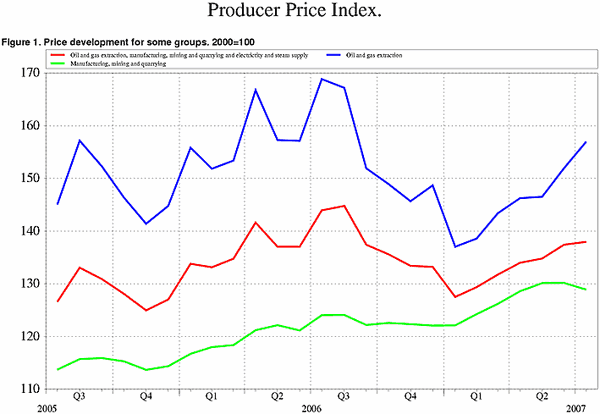Content
Published:
This is an archived release.
Fall in manufacturing prices
Norwegian producer prices for the manufacturing industries fell by 1 per cent from June to July, but a rise in the price of crude oil resulted in a 0.4 per cent increase in the total producer price index.
Several sub-indices for the manufacturing industries decreased from June to July, resulting in a 1.0 per cent fall in the manufacturing index. The index for crude petroleum and natural gas rose by 3.3 per cent, mainly due to a 5.6 per cent increase in oil prices (Brent Blend in NOK). The total producer price index thus increased by a slight 0.4 per cent.
The fall in the manufacturing index was caused primarily by lower prices of refined petroleum products and metals. The price index for basic metals rose sharply last year and in early 2007. Following a peak in the spring months the index has seen two consecutive months of decline, falling by 4.9 per cent from June to July. According to the London Metal Exchange the price of nickel was 27.5 per cent lower in July than in June. Prices of aluminium also fell.
Water reservoir levels are high after a rainy summer, contributing to high power production and lower electricity prices. The price index for electricity is down 25.6 per cent from June to July.
The index for food products and beverages was virtually unchanged from June to July. Prices of wood and wood products have also been relatively stable during the last few months, following a period of unusually high price growth. The index change for wood prices from June to July was 0.3 per cent.
Twelve-month change: Down 4.2 per cent
The total producer price index was 4.2 per cent lower in July compared with the same month last year. Energy prices were the main reason behind the fall, with a 7 per cent decrease in the index of crude oil and natural gas and a massive 59.7 per cent slump in the electricity index. Following the decrease in metal prices during the last month, the index for basic metals is 8.4 per cent lower than twelve months ago. This is the lowest twelve-month change in the index since November 2005. The aforementioned period of growth in wood prices is evident in an 18.1 per cent higher index compared with July last year.
| Producer price index |
| July 2007 | Changes, per cent | ||||||||||||||||||||||||||||||||||||||
|---|---|---|---|---|---|---|---|---|---|---|---|---|---|---|---|---|---|---|---|---|---|---|---|---|---|---|---|---|---|---|---|---|---|---|---|---|---|---|---|
| June 2007-July 2007 | July 2006-July 2007 | ||||||||||||||||||||||||||||||||||||||
| Total index | 138.0 | 0.4 | -4.2 | ||||||||||||||||||||||||||||||||||||
| Oil and gas extraction | 157.0 | 3.3 | -7.0 | ||||||||||||||||||||||||||||||||||||
| Manufacturing, mining and quarrying | 128.8 | -1.0 | 3.9 | ||||||||||||||||||||||||||||||||||||
| Electricity, gas and steam supply | 122.5 | -26.4 | -59.7 | ||||||||||||||||||||||||||||||||||||
| Commodity price index for the industrial sectors |
| July 2007 | Changes, per cent | ||||||||||||||||||||||||||||||||||||||
|---|---|---|---|---|---|---|---|---|---|---|---|---|---|---|---|---|---|---|---|---|---|---|---|---|---|---|---|---|---|---|---|---|---|---|---|---|---|---|---|
| June 2007-July 2007 | July 2006-July 2007 | ||||||||||||||||||||||||||||||||||||||
| Total index | 144.1 | 0.4 | -4.2 | ||||||||||||||||||||||||||||||||||||
| Oil and gas extraction | 157.0 | 3.3 | -7.0 | ||||||||||||||||||||||||||||||||||||
| Manufacturing, mining and quarrying | 129.1 | -1.0 | 3.9 | ||||||||||||||||||||||||||||||||||||
| Electricity, gas and steam supply | 118.5 | -26.4 | -59.7 | ||||||||||||||||||||||||||||||||||||
Additional information
Contact
-
Producer price index
E-mail: produsentpris@ssb.no
tel.: (+47) 21 09 40 00
-
Elisabeth Mælum
E-mail: elisabeth.maelum@ssb.no
tel.: (+47) 97 01 28 49
-
Morten Madshus
E-mail: morten.madshus@ssb.no
tel.: (+47) 40 90 26 94
-
Monika Græsli Engebretsen
E-mail: monika.graesli.engebretsen@ssb.no
tel.: (+47) 40 90 23 71
-
Håvard Georg Jensen
E-mail: havard.jensen@ssb.no
tel.: (+47) 40 90 26 86

